External Reference Material
Page 1 ~ Page 2 ~ Page 3 ~ Page 4 ~ Page 5 ~ Page 6
 Understanding Mali: Connections and Confrontations between the Tuareg, Islamist Rebels, and the Government [Kindle Edition]
Understanding Mali: Connections and Confrontations between the Tuareg, Islamist Rebels, and the Government [Kindle Edition]
BY:Ashley Heacock
May 2013
est 47 PAGES
This digital book is based around the three main players who took part in the 2012/2013 conflict in Mali: the Tuareg, Islamist rebels, and the Malian government. Tuareg rebels want their own state, or at least greater autonomy and political and economic opportunities; yet, there are many rivalries in the north between and even among different ethnic groups. Islamist rebels want to create an Islamist state in the north based on a brutal form of shari’a law, and they use drug smuggling and hostage taking as financial means. The government in Bamako wants to keep the country together and limit Tuareg and Islamist influence, but also has complicated and corrupted interests in the conflict itself. What can be done to solve the crisis, and what can stability practitioners use to counter instability and sources of insecurity? What can history and a deeper look at ethnic and racial grievances tell us? From the origins of Al-Qa'ida in the Islamic Maghreb (AQIM), to the reasons for the coup d'etat in 2012, to the underpinnings of colonialism that helped shape Tuareg demands, Understanding Mali takes a holistic view of the current conflict in Mali, explaining all variables and perspectives in a clear and concise manner.
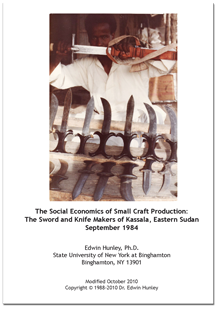 The Social Economics of Small Craft Production:
The Social Economics of Small Craft Production:
The Sword and Knife Makers of Kassala, Eastern Sudan
BY:Edwin Hunley, Ph.D.
September 1984
48 PAGES - 1.28 MB
Modified October 2010Copyright © 1988-2010
Dr. Edwin Hunley
IntroductionThe sword and knife makers of Kassala are a contemporary example of pre-industrialcraft manufacture. Their production technology is essentially unchanged from thatpracticed centuries ago. While a pre-medieval simple technology has persisted, thecommunity of craftsmen has expanded to a national market and developed new culturallyappropriate methods of organizing production and a democratic mechanism for addressingtheir material interests.This paper will present a multi-component investigation of the production and governancesystems of the Blacksmith's Market (Suq al Haddad) in Kassala. In addition to economicand technological issues, it will consider the contributory roles of history, culture,ethnicity and religion in the creation of a contemporary industrial enterprise whichmust be considered a social and economic success by virtually any standards. For example,under the current systems, over 400 craftsmen earn their living with incomes oftenexceeding by three to four times that normally available within the local economy.The organizational features of the production and governance system have possibleapplication in the design of small scale economic development and income generatingprojects. The features offer an alternative to the "cooperative" form of resourceownership and management often applied in inappropriate ethnic and cultural contexts.They appear to embody a spirit of community (social solidarity and public good) seldomfound in multi-ethnic situations or those characterized by competing extended familygroups. The cooperative model involves the common ownership and management ofproductive resources, and is often suggested as a device to democratize production bypreempting middlemen, usually merchants, who acquire a monopoly over credit, capitalmarketing, transportation or other input other than labor. In practice, the performancesof cooperatives have been at best spotty (Cf., Widstrand 1970a, Oakeshott 1978 andBardeleben 1973), but little attention has been given to the research and developmentof alternative models.
The organization of the Suq's governance and mutual benefit association is cooperativein form, but is separate from the organization of production. Production rests uponcooperation between independent specialized craftsmen who own their tools and theirworkplace and three large merchants who coordinate production and supply rawmaterials. Parallel to this "modern" system is a "traditional" system where an individualcraftsman and his helpers produce for the market in the manner of the Medieval Guilds.The checks and balances of the governance and production systems prevent the merchantsfrom obtaining a production and marketing monopoly which is usually prerequisite forsome form of socio-economic abuse.The presentation will also show that the Suq's situation is the consequence of severalparticularities, some of which are influenced by the larger cultural phenomenon ofsword and knife possession. For example, the continued existence of a market for theSuq's products lies in the continued importance of certain historical cultural featuresassociated with swords and knives and the specific designs and cultural history of theproducts themselves. These features will be presented in the appendix.
 OPERATION BANNER:
OPERATION BANNER:
An Analysis of Military Operations in Northern Ireland
BY: Ministry of Defense (MOD)
July 2006
98 PAGES - 7.04MB
FOREWORD By: General Sir Mike Jackson GCB CBE DSO ADC Gen
The military operations which started in Northern Ireland in 1969 will, without a doubt, be seen as one of the most important campaigns ever fought by the British Army and its fellow Services. That campaign is the longest to date; one of the very few waged on British soil; and one of the very few ever brought to a successful conclusion by the armed forces of a developed nation against an irregular force. This publication is a reflection on that campaign that seeks to capture its essence; it does not claim to be the definitive analysis. The great majority of officers and soldiers joining the Army aged 18 will be discharged aged 55, if not before; a total of 37 years. At the time of writing Operation BANNER has run for almost 37 years. Almost nobody in the Army has served throughout its length. Thus, whilst many have served in Northern Ireland, no-one can say they experienced all of it. Service in Northern Ireland has affected a whole generation of servicemen and women. The immediate tactical lessons of Operation BANNER have already been exported elsewhere, with considerable success. Operations in the Balkans, Sierra Leone, East Timor, Afghanistan and Iraq have already demonstrated both the particular techniques and the levels of expertise learnt through hard experience, both on the streets and in the fields of Northern Ireland. This publication does not seek to capture those lessons. Instead, it considers the high-level general issues that might be applicable to any future counter insurgency or counter terrorist campaign which the British armed forces might have to undertake. It is not intended as a history. In a small way it is a tribute to those who served there; particularly those who died or were wounded. But whilst honouring their Service it is critically important to consider what they learned. It is important to learn from their successes, which were considerable. It is no less important to learn from mistakes, where they were made, and to ensure that they are not repeated. The publication seeks to stimulate thought and will have failed if whatever is written is slavishly and unthinkingly applied to future operations.

Connecting the Dots: Education and Religious Discrimination in Pakistan A Study of Public Schools and Madrassas
BY: Azhar Hussain (ICRD) and
Ahmad Salim with Arif Naveed (SDPI)
December 2009
139 PAGES - 1.22MB
PREFACE By: Leonard A. Leo, USCIRF Chair
Education is critical. This is especially true in Pakistan, an ethnically and religiously diverse nation of around 180 million people. Precisely because of this diversity, education plays a critical role in the fabric of Pakistani life, with the potential of bringing the society together or tearing it apart. Especially important are the roles that educators play: how and what they teach and the curricula they use deeply influences whether children appreciate and respect ethnic and religious diversity or view religious minorities negatively, as valueless and aliens in their own country. Once instilled early in life, negative attitudes often resist change and can factor into the disintegration of the social fabric of communities, discrimination, and even sectarian violence.
The U.S. Commission on international religious Freedom (USCIRF), an independent and bipartisan U.S. government commission separate from the State department, has actively monitored the troubling rise in violent religious extremism across Pakistan that targets religious minorities as well as members of the majority Muslim faith. USCIRF has concluded that promoting respect for freedom of religion or belief must be an integral part of U.S. strategy in South Asia. the conflict with violent religious extremists now taking place in Pakistan requires the United States to understand and factor into its polices an understanding of the roots of this extremism and actively bolster the position of those elements in society that respect democratic values, the rule of law, and international standards of human rights, including freedom of religion or belief. Education reform is a key part of this effort.
In our 2011 annual report, USCIRF found that textbooks used in Pakistani primary and secondary schools foster prejudice and intolerance of religious minorities, especially Hindus and Christians. Such intolerant references are not restricted to Islamic studies textbooks: they are found in both early elementary and more advanced social studies texts used by all public school students, including non-Muslims. Moreover, the textbooks contain stories, biographies, and poems with an Islamic religious character that students of minority faiths must study and be tested on.
In addition, a significant minority of Pakistan’s thousands of religious schools, or madrassas, reportedly continue to provide ideological training and motivation to those who take part in religiously-inspired violence in Pakistan and abroad. A memorandum of understanding signed in October 2010 between the ministries of Interior, which oversees the madrassa system and the five main madrassa boards, was an attempt to better regulate their curriculum and financing. However, further implementation has stalled and the curriculum remains unreformed. In its advisory role, USCIRF recommended in 2011 that the U.S. government urge the government of Pakistan and appropriate provincial authorities to, inter alia:
- set national textbook and curricula standards that actively promote tolerance toward all persons, and establish appropriate review and enforcement mechanisms to guarantee that such standards are being met in government (public) schools;
- move quickly to implement improved guidelines for textbooks used in public schools and to replace current public school textbooks with ones that exclude messages of intolerance, hatred, or violence against any group of persons based on religious or other differences; and
- ensures that a madrassa oversight board is empowered to develop, implement, and train teachers in human rights standards, and to provide oversight of madrassa curricula and teaching standards.
Because of the enormity of the challenge and the importance of these concerns, and to provide more detailed recommendations to American policymakers, USCIRF funded a study by the international Center for religion and diplomacy (ICRD) to examine the social studies, Islamic studies, and Urdu textbooks and pedagogical methods in Pakistan’s public school system and its madrassa system, and to interview teachers and students about their views towards religious minorities. The goal of this study was to explore what linkages, if any, exist between the portrayal of religious minorities in Pakistan’s public schools and madrassas, biases that exist toward these minorities, and acts of discrimination or extremism resulting from such biases.
To these ends, ICRD examined: the portrayal of religious minorities in these text- books, with an emphasis on determining the degree to which negative stereotypes and/or biased portrayals of religious minorities exist, as well as positive examples of teaching about tolerance and respecting differences; the degree to which biases against religious minorities result from how these minorities are portrayed in these educational systems; and the degree to which systemic biases towards other religious groups are ingrained in the administration of public schools and madrassas. Based on these findings, ICRD recommended how best to counter the negative stereotyping to which students are exposed in their schooling and education.
ICRD, with the independent Pakistani think tank Sustainable development Policy institute, reviewed more than 100 textbooks from grades 1-10 from all of Pakistan’s four provinces. In addition, students and teachers from public schools and madrassas were interviewed in Khyber Pakhtunkhwa (formerly known as the North-West Frontier Province), Balochistan, Sindh, and Punjab. Thirty-seven middle and high schools were visited, with 277 students and teachers interviewed individually or in group settings. Two hundred and twenty-six madrassa students and teachers were interviewed from 19 madrassas.
The results are eye opening and concerning.
Public school textbooks used by all children often were found to have a strong Islamic orientation, while Pakistan’s religious minorities were either referenced derogatorily or omitted all together. Hindus, one of Pakistan’s religious minorities, were described in especially negative terms, and references to Christians were often inaccurate and offensive. Madrassa textbooks generally portrayed non-Muslims in one of three ways: (1) kafirs (infidels) or mushrakeen (pagans), (2) dhimmis (non-Muslims Living under Islamic rule), or (3) murtids (apostates, i.e. people who have turned away from Islam). Non-Muslims were never described as citizens with the constitutionally- protected rights which accompany citizenship. Tolerant references were found in both systems, often intermixed with neutral and intolerant references, leaving some room — albeit complicated — for improvement.
Interviews with public school and madrassa teachers demonstrated that they had limited awareness or understanding of religious minorities and their beliefs, and were divided on whether a religious minority was a citizen. Views expressed by teachers about Ahmadis, Christians, and Jews often were very negative. Interviews showed that these biased sentiments were transmitted and held by the students.
This is the first study of this scope, examining Pakistan’s public school and madrassa textbooks, as well as the attitudes of students and teachers in all four provinces. As the reader will see, the findings of the study and the recommendations reinforce USCIRF’s conclusion that education reform incorporating themes of religious tolerance is critical for the development of a tolerant Pakistani society that values religious freedom and religious diversity for all its citizens. This is in the interest of both the United States and all Pakistanis.

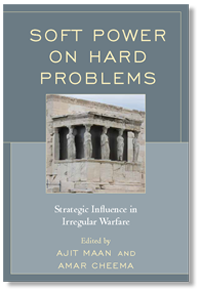
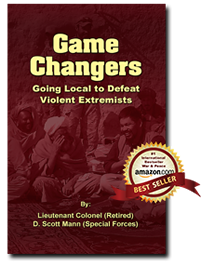
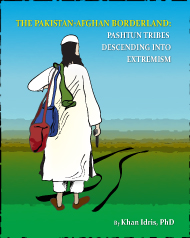
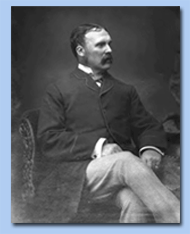 The Private Journal of
The Private Journal of